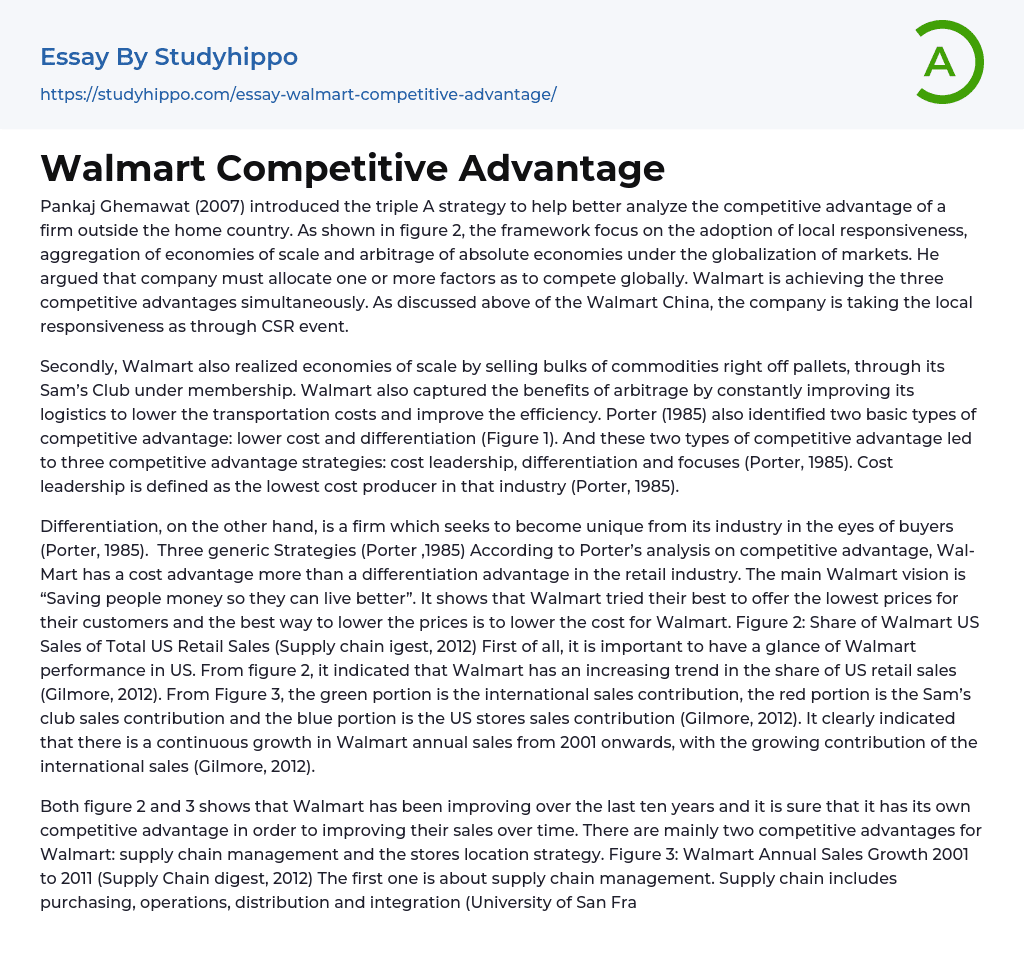Pankaj Ghemawat (2007) introduced the triple A strategy to aid in the analysis of a firm's competitive advantage in foreign markets. The strategy, as illustrated in figure 2, emphasizes the adoption of local responsiveness, aggregation of economies of scale, and arbitrage of absolute economies in a globalized market. Ghemawat argues that companies must allocate one or more of these factors in order to compete on a global scale. Walmart successfully achieves all three competitive advantages concurrently. As previously discussed in relation to Walmart China, the company demonstrates local responsiveness through its CSR events.
Walmart realized economies of scale by selling bulk commodities directly from pallets through its membership-based Sam’s Club. Additionally, the company benefited from arbitrage by consistently improving its logistics to reduce transportation costs and enhance efficiency. According to
...Porter (1985), there are two core types of competitive advantage: lower cost and differentiation (Figure 1). These two types of competitive advantage result in three strategies: cost leadership, differentiation, and focus (Porter, 1985). Cost leadership is described as being the industry's lowest-cost producer (Porter, 1985).
Differentiation is a firm that aims to distinguish itself from its industry in the eyes of buyers (Porter, 1985). According to Porter's analysis on competitive advantage, Wal-Mart has a cost advantage rather than a differentiation advantage in the retail industry. Wal-Mart's main vision is to "save people money so they can live better," indicating their commitment to offering the lowest prices for customers by reducing costs. Figure 2 shows the share of Wal-Mart's US sales in the total US retail sales, demonstrating an increasing trend (Supply Chain Digest, 2012). Figure 3 represents the contribution of international
sales, Sam's club sales, and US stores sales, indicating a continuous growth in Wal-Mart's annual sales since 2001, with a growing contribution from international sales (Gilmore, 2012).
Both figure 2 and 3 depict the improvement of Walmart over the past decade, highlighting its competitive advantage in enhancing sales. Walmart's supply chain management and store location strategy are the two main factors contributing to this advantage. In Figure 3, titled "Walmart Annual Sales Growth 2001 to 2011" (Supply Chain digest, 2012), it showcases how Walmart has effectively managed its supply chain. This includes various aspects such as purchasing, operations, distribution, and integration (University of San Francisco ,n. d.).
Walmart achieved great success in supply chain management through three main strategies: vendor partnership, cross docking, and advanced technology (University of San Francisco ,n. d. ). By establishing vendor partnerships, Walmart was able to negotiate lower prices from suppliers due to their large volume of purchases (University of San Francisco ,n. d. ). This enabled Walmart to offer its customers lower prices and fulfill its commitment to them. Another cost-saving strategy employed by Walmart is crossdocking (University of San Francisco ,n. d. ).
Crossdocking is a method of transferring goods from suppliers to customers without entering the warehouse or storing in distribution centers for a long period of time (Kulwiec, 2004). This approach helps save transportation and storage costs. Another strategy employed by Walmart in supply chain management is the implementation of advanced technology. Walmart has made significant investments in technology to predict consumer demand and effectively manage inventory levels to prevent overstocking (University of San Francisco, n.d.). Another important aspect is Walmart's store location
strategy.
The two important factors for Walmart are the location and the price of lands. Walmart is very careful in choosing their locations. The first store that opened in 1962 was situated in a small rural town where competition was less compared to urban and suburban areas (Gerdeman, 2012). Walmart patiently waited until they had enough resources before opening a new store (Gerdeman, 2012). To enhance the accessibility of their stores, Walmart prefers to have their big box stores located near a convenient highway exit (Holmes, 2011). See Figure 4 for the diffusion of Wal-Mart stores and general distribution centers.
The figure in Fettiq's (2006) study demonstrates the extensive network of Walmart stores. This network, combined with the distribution centers, plays a crucial role in reducing logistic costs and facilitating the transfer of skilled personnel and managers (Fettiq, 2006). Walmart's strategy includes purchasing land rather than relying solely on leases, aimed at decreasing rental expenses (Halkias, 2012). The company also benefits from subsidies and reduced-cost land provided by local government authorities to construct new stores and distribution centers (Mattera ; Purinton, 2004).
Therefore, Walmart is able to maintain its competitiveness in the market by acquiring lands and receiving subsidies. Additionally, Walmart has various advantages in the retail industry. By implementing crossdocking, Walmart reduces the cost of carrying inventory and obtains lower product costs. With a wide range of products available in its stores, Walmart caters to different consumer demands. Furthermore, Walmart offers competitive prices to uphold its mission of “Save Money, Live Better”. Moreover, Walmart benefits from its strategic location, which reduces distribution costs and operational expenses.
- Board Of Directors essays
- Brand Management essays
- Business Ethics essays
- Business Management essays
- Change Management essays
- Comparative Analysis essays
- Decision Making essays
- Dispute Resolution essays
- Knowledge Management essays
- Leadership essays
- Leadership and Management essays
- Manager essays
- Operations Management essays
- Performance Management essays
- Product Management essays
- Project Management essays
- Quality Management essays
- Risk essays
- Risk Management essays
- Scientific Management essays
- Stress Management essays
- supply chain management essays
- Time Management essays
- Total Quality Management essays
- Adidas essays
- Amazon essays
- Apple essays
- Bmw essays
- British Airways essays
- Burger King essays
- Coca-Cola essays
- Company essays
- Costco essays
- Dell essays
- Ebay essays
- Enron essays
- Facebook essays
- Ford Motor Company essays
- Gap essays
- General Motors essays
- Google essays
- Honda essays
- Ibm essays
- Ikea essays
- Intel essays
- Iphone essays
- Johnson and Johnson essays
- Kellogg essays
- Key essays
- Kfc essays




